To dry and store wild herbs for perfect tea, start by foraging in late spring or early summer, ideally in the morning. Choose vibrant, fresh herbs, and rinse them gently. Use air drying or a dehydrator, hanging them in a dark, ventilated area. Once dry, store your herbs in dark glass jars with airtight seals to keep moisture and light out. Label each jar with the herb name and date for easy identification. Maintaining the right temperature and humidity is key to preserving flavor and potency. Keep exploring to discover more tips for creating delightful herbal blends!
Importance of Drying Herbs

When you dry herbs, you preserve their flavor and potency, ensuring that they remain a valuable addition to your tea long after the growing season. Drying herbs allows you to capture their essential oils and active compounds, which contribute rich tastes and health benefits. Fresh herbs can quickly lose their quality, but by drying them, you lock in their vibrant flavors.
Moreover, drying extends the shelf life of your herbs, making them accessible throughout the year. You won't have to rely solely on store-bought options, which often lack the freshness and complexity of your hand-harvested varieties. Stored properly, dried herbs can remain potent for months, providing you with a reliable source for your favorite blends.
Another important aspect is the convenience of using dried herbs. They're lightweight and easy to store, allowing you to keep a diverse collection without taking up much space.
Plus, you can experiment with different combinations to create unique tea experiences, enhancing your daily routine. By embracing the drying process, you're not just preserving herbs; you're ensuring that your tea remains a delicious and healthful delight, no matter the season.
Best Time for Foraging
What's the best time for foraging wild herbs? The ideal time varies depending on the specific herb you're after, but generally, late spring to early summer is prime for most varieties. During this period, herbs are lush, vibrant, and packed with flavor and nutrients.
Early morning is often the best time to forage. The air is cooler, and dew still clings to the leaves, which can make the herbs crisper and more aromatic.
You'll also want to take into account the weather. After a good rain, herbs tend to be more vibrant and full of moisture, which can enhance their flavor. Avoid foraging during the hottest parts of the day when the sun is blazing, as this can stress the plants and affect their taste.
Additionally, keep an eye on the lunar cycle. Some foragers believe that harvesting during a waxing moon maximizes the potency of herbs.
Selecting Quality Herbs

Selecting quality herbs is essential for crafting the perfect cup of tea. When you're out foraging, keep an eye out for herbs that are vibrant and fresh. Look for those with rich colors and strong scents; these indicate high essential oil content and better flavor. Avoid any plants that show signs of wilting, yellowing, or pest damage, as these may affect the taste and safety of your tea.
Take the time to familiarize yourself with the specific herbs you're interested in. Knowing what to look for regarding shape, size, and color will help you identify the best specimens. Consider the environment where the herbs grow; they should ideally be in clean, unpolluted areas. If they're growing near roads or industrial sites, it's best to steer clear.
Additionally, harvest responsibly. Only take what you need, allowing the plants to continue growing for future foraging. This practice not only maintains the ecosystem but also guarantees you'll have quality herbs to come back to later.
Preparing Herbs for Drying
Before you start drying your herbs, it's important to prepare them properly to guarantee the best flavor and aroma in your tea. Begin by harvesting your herbs during the morning after the dew has dried but before the sun is too hot. This timing helps preserve their essential oils.
Next, rinse the herbs gently under cool water to remove any dirt or insects. Pat them dry with a clean towel or let them air dry for a few minutes. It's vital not to crush the leaves during this process, as this can release their oils prematurely.
Once your herbs are clean and dry, remove any damaged or yellowing leaves, focusing on only the healthiest parts. You can then bundle them together by tying the stems with a natural twine or string.
Here's a quick reference for preparing your herbs:
| Step | Description |
|---|---|
| Harvesting | Pick herbs in the morning, after dew. |
| Cleaning | Rinse gently, then pat dry. |
| Sorting | Remove damaged or yellow leaves. |
| Bundling | Tie stems together with natural twine. |
Following these steps guarantees your herbs are ready for drying!
Different Drying Methods

There are several effective methods for drying your herbs, each offering unique benefits. One popular technique is air drying, where you simply hang the herbs in bunches in a well-ventilated area away from direct sunlight. This method is easy and requires no special equipment.
If you're short on time or humidity is high, consider using a dehydrator. Set it to a low temperature, and you'll have dried herbs in just a few hours. This method retains flavor and color, making it a great choice for culinary herbs.
Another option is using an oven. Spread the herbs out on a baking sheet and set the oven to the lowest temperature, ideally around 180°F (82°C). Keep the door slightly ajar to allow moisture to escape. However, watch them closely to prevent burning.
Lastly, you can microwave your herbs for quick drying. Place them between two paper towels and microwave in short bursts. This method is fast but can be tricky, as it's easy to overdo it.
Choose the method that best suits your needs, and you'll be on your way to enjoying delicious herbal teas!
Monitoring Drying Process
Once you've chosen a drying method, keeping an eye on the drying process is important to confirm your herbs retain their flavor and potency. You should monitor the herbs regularly to verify they're drying evenly and not getting too brittle or moldy.
Drying Stages
| Stage | Signs to Look For |
|---|---|
| Initial Drying | Leaves are still flexible; aroma is mild. |
| Midway Point | Leaves begin to feel crunchy; aroma intensifies. |
| Final Stage | Leaves snap easily; color is vibrant and rich. |
During the drying process, make adjustments as needed. If you notice uneven drying, rotate or rearrange the herbs. It's also essential to check for signs of moisture, as this can lead to spoilage. Ideally, herbs should be fully dried within a few days.
A good rule of thumb is to test them by bending a leaf; if it snaps easily, they're ready. By actively monitoring the drying process, you confirm your wild herbs will deliver the best flavor and health benefits when you brew your perfect cup of tea.
Storing Dried Herbs Properly

Now that you've dried your herbs, it's essential to store them properly to maintain their flavor and potency.
You'll want to choose perfect storage containers, keep them in ideal temperature and humidity, and make sure to label and date each batch.
These steps will help you enjoy your wild herb teas at their best.
Ideal Storage Containers
When it comes to storing your dried herbs, choosing the right containers can make all the difference in preserving their flavor and potency.
Opt for dark glass jars, such as amber or cobalt, which protect your herbs from light that can degrade their quality over time. If you prefer something lightweight, consider using food-grade plastic containers, but make sure they're opaque to block light exposure.
Airtight seals are essential, so look for jars with rubber gaskets or screw-top lids to keep moisture out. Avoid using containers that previously held strong-smelling substances, as these can impart unwanted flavors to your herbs.
If you're storing smaller quantities, herb envelopes made of kraft paper are excellent; they allow your herbs to breathe while keeping them dry.
Just remember to label your containers with the herb name and date of storage for easy identification later.
Optimal Temperature and Humidity
Maintaining the ideal temperature and humidity for your dried herbs is essential for preserving their flavor and medicinal properties.
Store your herbs in a cool, dark place away from direct sunlight, heat sources, and humidity. An ideal temperature range is between 60°F to 70°F (15°C to 21°C). Temperatures above this can cause the herbs to lose their potency and flavor over time.
Humidity is equally important; too much moisture can lead to mold growth, while too little can cause your herbs to become brittle. Aim for a relative humidity of around 30-50%.
If you live in a particularly humid area, consider using silica gel packets or tight-sealing containers to absorb excess moisture.
Labeling and Dating Herbs
To guarantee you get the most out of your dried herbs, proper labeling and dating are key steps in the storage process. When you harvest and dry your herbs, it's crucial to keep track of when they were processed. This will help you identify their freshness and potency over time.
Make sure you use airtight containers to store your herbs, and always label them clearly. A simple label should include the herb's name, the date you dried it, and any specific notes, like the method of drying.
Here's a quick reference table for labeling your herbs:
| Herb Name | Date Dried | Notes |
|---|---|---|
| Chamomile | 2023-09-15 | Dried in the sun |
| Peppermint | 2023-09-20 | Dried using a dehydrator |
| Lavender | 2023-09-10 | Air dried indoors |
| Rosemary | 2023-09-12 | Dried with stems |
| Sage | 2023-09-18 | Dried in a dark place |
Optimal Storage Conditions
Proper storage conditions are essential for preserving the flavor and potency of your dried wild herbs. Start by choosing a cool, dark place, away from direct sunlight, as UV rays can degrade the quality of your herbs. A pantry or a cupboard works well. Make certain the temperature stays stable; ideally, it should be between 60°F and 70°F.
Next, use airtight containers to keep moisture and air at bay. Glass jars or metal tins with tight-fitting lids are great options. Avoid plastic bags, since they can trap moisture, leading to mold growth. If you use glass, opt for dark-colored jars to protect against light exposure.
Humidity is another factor to take into account. Keep your herbs in a dry environment; if you live in a humid area, think about adding a food-safe desiccant packet to your container. Check your herbs regularly for any signs of spoilage or moisture.
Lastly, store your herbs separately, as combining them can lead to flavor cross-contamination. By following these guidelines, you'll make certain your dried wild herbs remain vibrant and flavorful for your homemade teas.
Creating Herbal Tea Blends
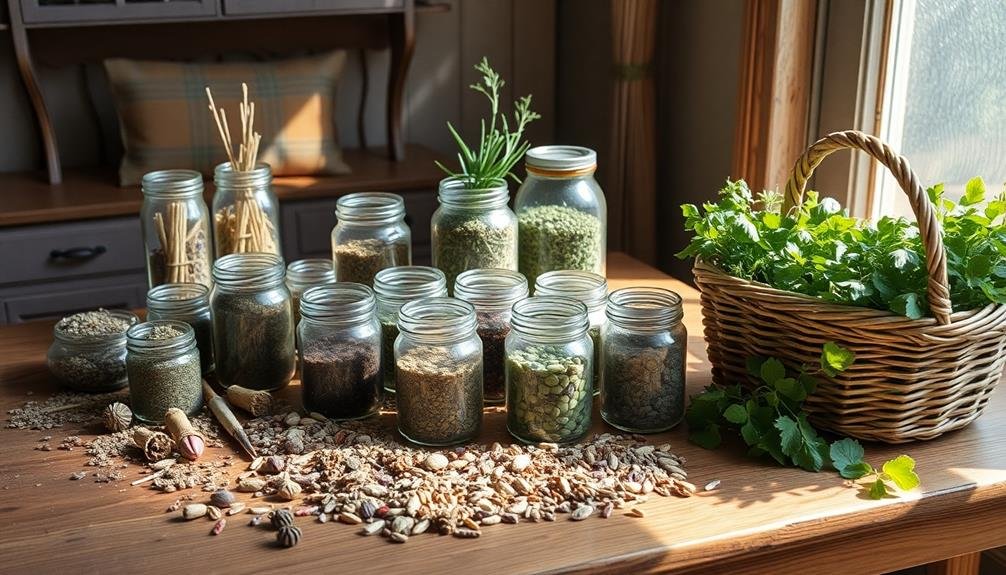
Creating herbal tea blends can be a delightful and rewarding experience. Start by choosing your favorite dried herbs; consider flavors, aromas, and benefits. Popular choices include chamomile for relaxation, peppermint for digestion, and hibiscus for its tartness.
Next, experiment with proportions. A good rule of thumb is to use one part of a strong flavor (like ginger) to two parts of milder herbs (like lemon balm). This balance keeps your blend harmonious.
Don't be afraid to mix and match; sometimes the most surprising combinations yield the best results.
Once you've decided on your blend, taste-test small batches. Brew a cup using a teaspoon of your mix and adjust according to your preferences.
You might find that you need to tweak the ratios or add a new herb entirely to achieve your desired flavor profile.
Using Dried Herbs in Tea
Dried herbs can transform your tea experience, adding unique flavors and health benefits with every sip. When you choose the right dried herbs, you're not just brewing a beverage; you're creating a wellness ritual. The key is to understand how different herbs interact and complement each other.
Here's a handy table to guide you through some popular dried herbs, their flavors, and potential health benefits:
| Herb | Flavor Profile | Health Benefits |
|---|---|---|
| Chamomile | Sweet, floral | Calming, aids sleep |
| Peppermint | Cool, invigorating | Digestive aid, relieves headaches |
| Lavender | Floral, slightly sweet | Reduces anxiety, promotes relaxation |
| Lemon Balm | Citrusy, herbal | Mood booster, improves sleep |
| Ginger | Spicy, warm | Anti-inflammatory, aids digestion |
Feel free to mix and match these dried herbs to craft your perfect tea blend. Experimenting will help you discover new favorites and enhance your overall tea-drinking experience. Enjoy the journey of flavor and wellness that comes with each cup!
Tips for Flavor Enhancement
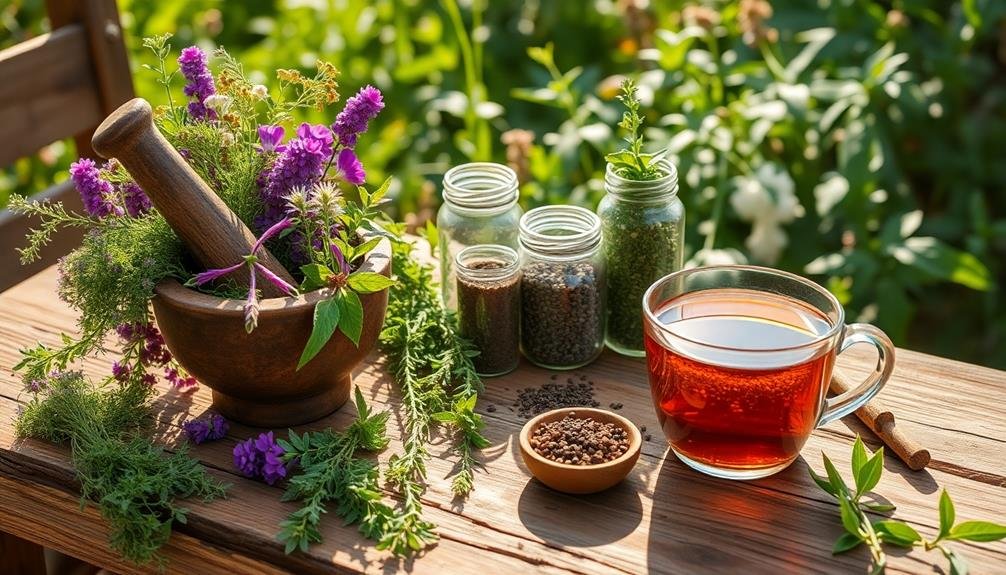
To enhance the flavor of your herbal tea, start with quality herbs that are fresh and vibrant.
Proper drying techniques also play an essential role in preserving their natural taste and aroma.
Choose Quality Herbs
When selecting herbs for tea, it's essential to prioritize quality to enhance flavor. Freshness and potency can make a significant difference in your brew. Look for vibrant leaves, rich aromas, and no signs of wilting or browning. Quality herbs not only taste better but also offer more health benefits.
Here's a quick guide to help you choose the best herbs for your tea:
| Herb | Flavor Profile |
|---|---|
| Peppermint | Invigorating and revitalizing |
| Chamomile | Sweet and calming |
| Thyme | Earthy and robust |
When you're foraging or purchasing, pay attention to the growing conditions. Herbs grown in nutrient-rich soil and harvested at the right time will yield superior flavors. Don't hesitate to taste the herbs before committing to them. This not only helps to ascertain quality but lets you discover new flavors you might love. Remember, your tea experience starts with the herbs you choose, so make them count!
Proper Drying Techniques
Effective drying techniques are essential for preserving the vibrant flavors and aromas of your wild herbs. To start, make sure you wash your herbs gently to remove any dirt or insects, then pat them dry with a clean towel.
Choose a drying method that suits the type of herbs you're working with; air drying is ideal for sturdy herbs like rosemary and thyme, while delicate herbs like basil might do better in a dehydrator.
When air drying, bundle your herbs and hang them upside down in a warm, dark, and well-ventilated area. This prevents mold and preserves color. If you're using a dehydrator, set it at a low temperature to avoid cooking the herbs, which can diminish their flavor.
Check your herbs regularly; they're ready when they're crispy to the touch, not chewy. Store the dried herbs in airtight containers away from light and moisture to maintain their potency.
Frequently Asked Questions
Can I Dry Herbs in Direct Sunlight?
You can dry herbs in direct sunlight, but it's not ideal. The intense heat can degrade flavor and color. Instead, try a shaded, well-ventilated area for better preservation of your herbs' qualities.
How Long Do Dried Herbs Last?
Dried herbs typically last six months to a year when stored properly. You should keep them in a cool, dark place in airtight containers. Always check for potency and freshness before using them in your dishes.
Are There Any Herbs That Shouldn't Be Dried?
Some herbs, like basil and cilantro, lose flavor and aroma when dried. You'll want to use them fresh instead. Others, like rosemary and thyme, dry well and retain their qualities, making them great for storage.
Can I Use a Microwave to Dry Herbs?
Yes, you can use a microwave to dry herbs, but be cautious. Place them between paper towels, microwave in short bursts, and check frequently to avoid over-drying or burning. It's quick but requires attention.
What Are Signs of Spoiled Dried Herbs?
When you examine dried herbs, look for signs like discoloration, a musty smell, or an off-taste. If they're brittle or lack aroma, they've likely spoiled, and it's best to toss them out.
In Summary
In summary, drying and storing wild herbs is a rewarding process that enhances your tea experience. By foraging at the right time and selecting quality herbs, you'll guarantee the best flavors. Remember to prepare and dry them properly, then store them in ideal conditions to preserve their potency. Don't hesitate to experiment with herbal blends and flavor enhancements. With a little practice, you'll enjoy delicious, homemade herbal teas that keep you connected to nature.

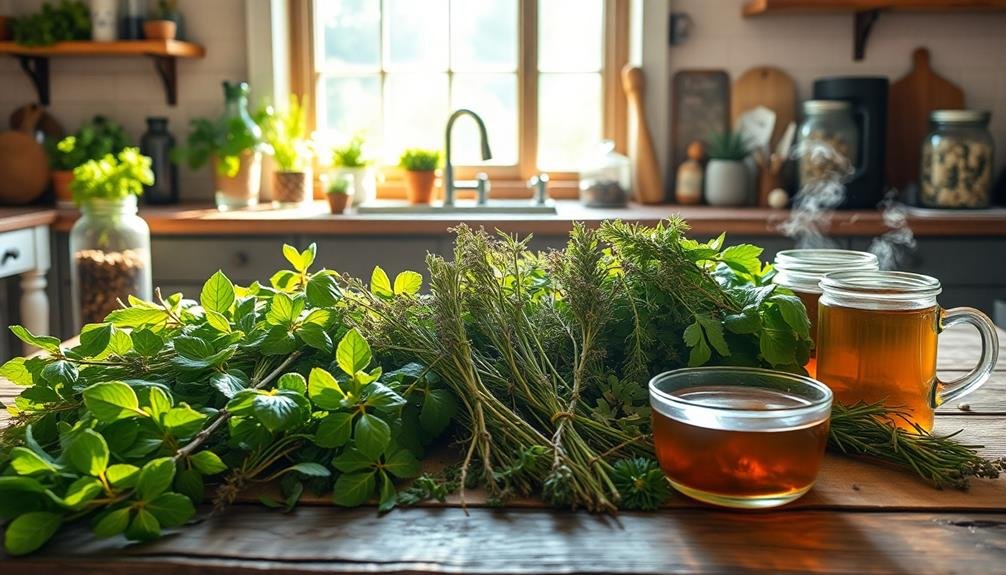
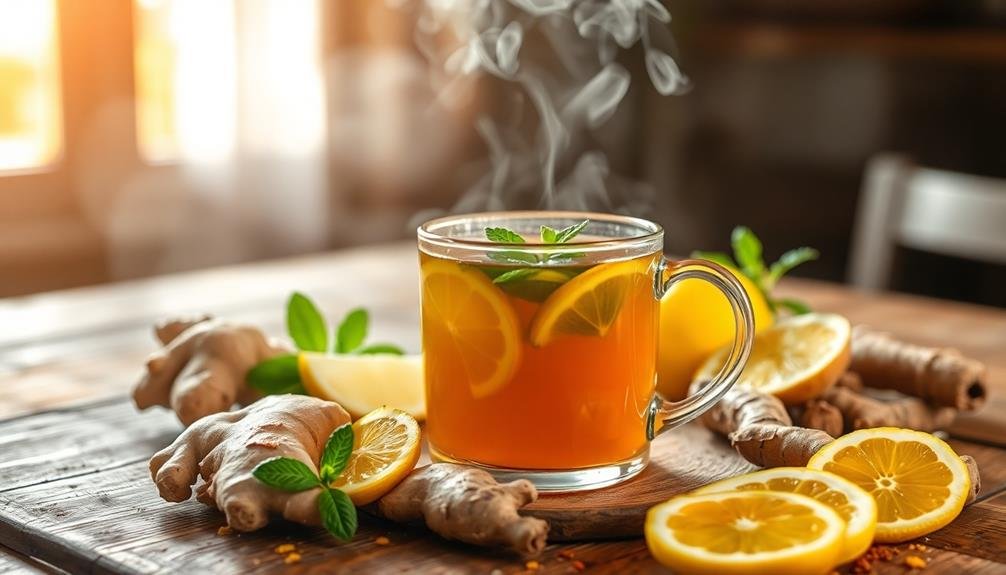
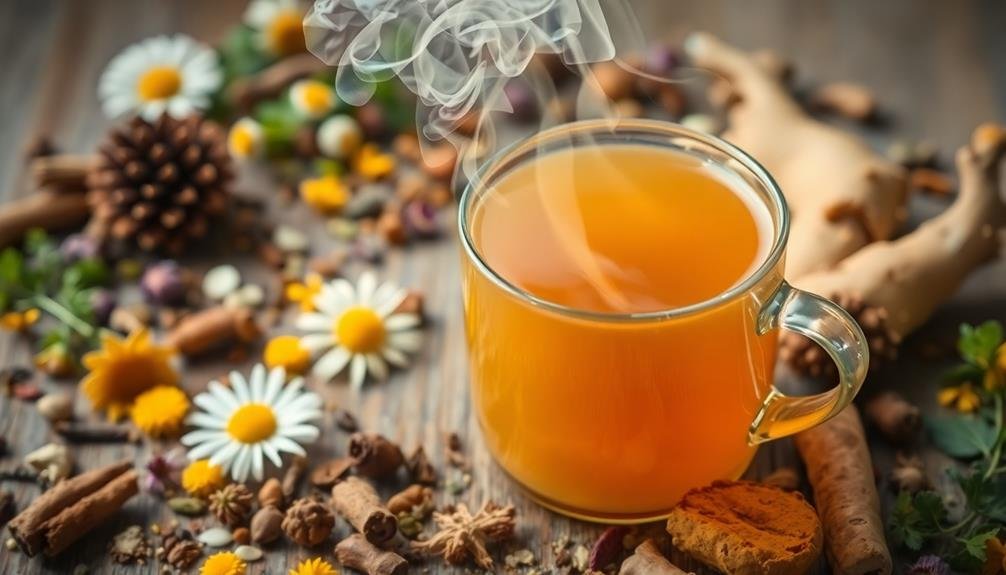
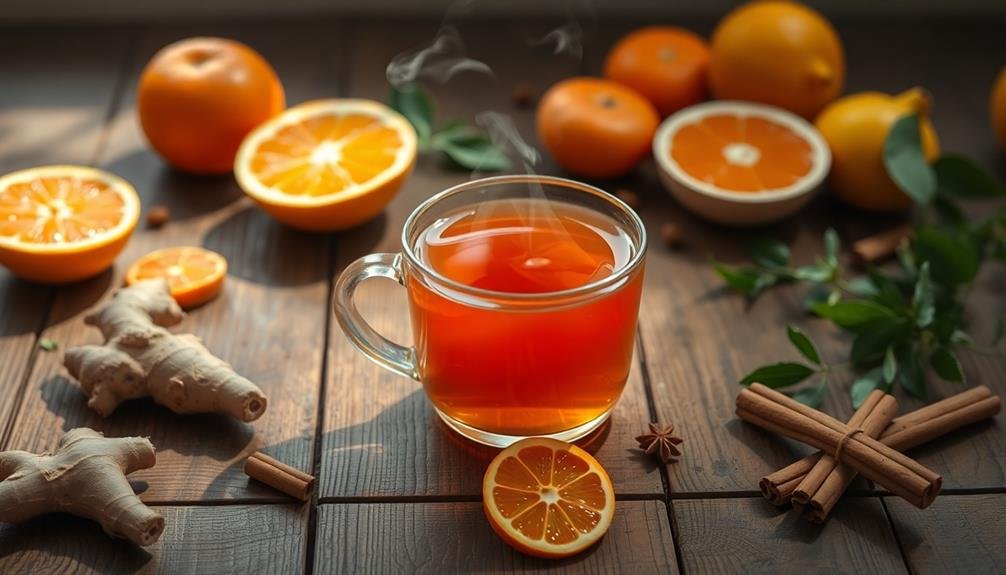
Leave a Reply